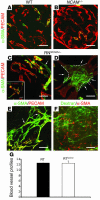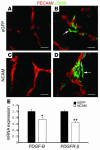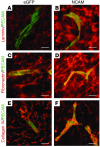Pericytes limit tumor cell metastasis
- PMID: 16470244
- PMCID: PMC1361347
- DOI: 10.1172/JCI25705
Pericytes limit tumor cell metastasis
Abstract
Previously we observed that neural cell adhesion molecule (NCAM) deficiency in beta tumor cells facilitates metastasis into distant organs and local lymph nodes. Here, we show that NCAM-deficient beta cell tumors grew leaky blood vessels with perturbed pericyte-endothelial cell-cell interactions and deficient perivascular deposition of ECM components. Conversely, tumor cell expression of NCAM in a fibrosarcoma model (T241) improved pericyte recruitment and increased perivascular deposition of ECM molecules. Together, these findings suggest that NCAM may limit tumor cell metastasis by stabilizing the microvessel wall. To directly address whether pericyte dysfunction increases the metastatic potential of solid tumors, we studied beta cell tumorigenesis in primary pericyte-deficient Pdgfb(ret/ret) mice. This resulted in beta tumor cell metastases in distant organs and local lymph nodes, demonstrating a role for pericytes in limiting tumor cell metastasis. These data support a new model for how tumor cells trigger metastasis by perturbing pericyte-endothelial cell-cell interactions.
Figures








References
-
- Ellis LM, Fidler IJ. Angiogenesis and metastasis. Eur. J. Cancer. 1996;32A:2451–2460. - PubMed
-
- Thiery JP. Epithelial-mesenchymal transitions in tumour progression. Nat. Rev. Cancer. 2002;2:442–454. - PubMed
-
- Hanahan D. Heritable formation of pancreatic beta-cell tumours in transgenic mice expressing recombinant insulin/simian virus 40 oncogenes. Nature. 1985;315:115–122. - PubMed
-
- Perl AK, et al. Reduced expression of neural cell adhesion molecule induces metastatic dissemination of pancreatic beta tumor cells. Nat. Med. 1999;5:286–291. - PubMed
-
- Roesler J, Srivatsan E, Moatamed F, Peters J, Livingston EH. Tumor suppressor activity of neural cell adhesion molecule in colon carcinoma. Am. J. Surg. 1997;174:251–257. - PubMed
Publication types
MeSH terms
Substances
LinkOut - more resources
Full Text Sources
Other Literature Sources
Medical
Molecular Biology Databases
Research Materials
Miscellaneous

